- Lý Thuyết Vectơ Trong Không Gian Lớp 12
- Các Dạng Bài Tập Trắc Nghiệm Vectơ Trong Không Gian Lớp 12 Giải Chi Tiết
Các dạng bài tập trắc nghiệm vectơ trong không gian lớp 12 giải chi tiết được soạn dưới dạng file word và PDF gồm 7 trang. Các bạn xem và tải về ở dưới.
DẠNG 1: CÁC PHÉP VECTƠ TRONG KHÔNG GIAN
Câu 1. Cho hình tứ diện $ABCD$ có trọng tâm $G$ và $O$ là một điểm bất kỳ. Mệnh đề nào sau đây đúng?
A. $\overrightarrow {OG} = \frac{1}{3}\left( {\overrightarrow {OA} + \overrightarrow {OB} + \overrightarrow {OC} + \overrightarrow {OD} } \right)$. B. $\overrightarrow {OG} = \frac{1}{2}\left( {\overrightarrow {OA} + \overrightarrow {OB} + \overrightarrow {OC} + \overrightarrow {OD} } \right)$.
C. $\overrightarrow {OG} = \frac{1}{4}\left( {\overrightarrow {OA} + \overrightarrow {OB} + \overrightarrow {OC} + \overrightarrow {OD} } \right)$. D. $\overrightarrow {OG} = \overrightarrow {OA} + \overrightarrow {OB} + \overrightarrow {OC} + \overrightarrow {OD} $.
Lời giải
Chọn C theo lý thuyết
Câu 2. Cho hình tứ diện $ABCD$ có trọng tâm $G$ và $O$ là một điểm bất kỳ. Gọi $I$, $J$ lần lượt là trung điểm của $AB$, $CD$. Mệnh đề nào sau đây đúng?
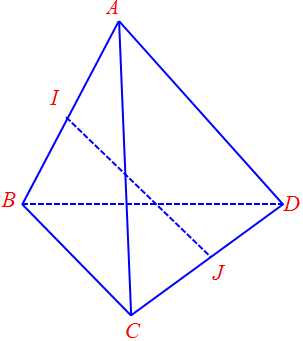
A. $\overrightarrow {OG} = \overrightarrow {OI} + \overrightarrow {OJ} $. B. $\overrightarrow {OG} = \frac{1}{2}\left( {\overrightarrow {OI} + \overrightarrow {OJ} } \right)$.
C. $\overrightarrow {OG} = 2\left( {\overrightarrow {OI} + \overrightarrow {OJ} } \right)$. D. $\overrightarrow {OG} = \frac{1}{4}\left( {\overrightarrow {OI} + \overrightarrow {OJ} } \right)$.
Lời giải
Chọn B, ta có:
$\overrightarrow {OG} = \frac{1}{4}\left( {\overrightarrow {OA} + \overrightarrow {OB} + \overrightarrow {OC} + \overrightarrow {OD} } \right) = \frac{1}{4}\left( {2\overrightarrow {OI} + 2\overrightarrow {OJ} } \right) = \frac{1}{2}\left( {\overrightarrow {OI} + \overrightarrow {OJ} } \right)$
Câu 3. Cho hình hộp $ABCD.A’B’C’D’$. Mệnh đề nào sau đây đúng?
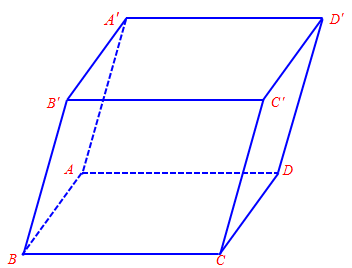
A. $\overrightarrow {AB} + \overrightarrow {AA’} + \overrightarrow {AD} = \frac{1}{2}\overrightarrow {AC’} $. B. $\overrightarrow {AB} + \overrightarrow {AA’} + \overrightarrow {AD} = 2\overrightarrow {AC’} $.
C. $\overrightarrow {AB} + \overrightarrow {AA’} + \overrightarrow {AD} = 3\overrightarrow {AC’} $. D. $\overrightarrow {AB} + \overrightarrow {AA’} + \overrightarrow {AD} = \overrightarrow {AC’} $.
Lời giải
Chọn D theo quy tắt hình hộp
Câu 4. Cho hình hộp $ABCD.A’B’C’D’$và $I$ là giao điểm của $BD’$ và $B’D$. Mệnh đề nào sau đây đúng?
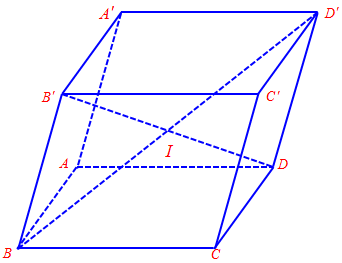
A. $\overrightarrow {BA} + \overrightarrow {BC} + \overrightarrow {BB’} = 2\overrightarrow {BI} $. B. $\overrightarrow {BA} + \overrightarrow {BC} + \overrightarrow {BB’} = \overrightarrow {BI} $.
C. $\overrightarrow {BA} + \overrightarrow {BC} + \overrightarrow {BB’} = \frac{1}{2}\overrightarrow {BI} $. D. $\overrightarrow {BA} + \overrightarrow {BC} + \overrightarrow {BB’} = 3\overrightarrow {BI} $.
Lời giải
Chọn A theo quy tắt hình hộp ta có: $\overrightarrow {BA} + \overrightarrow {BC} + \overrightarrow {BB’} = \overrightarrow {BD’} = 2\overrightarrow {BI} $
Câu 5. Cho hình hộp $ABCD.A’B’C’D’$ và $G$ là trọng tâm tam giác $BA’D$. Mệnh đề nào sau đây đúng?
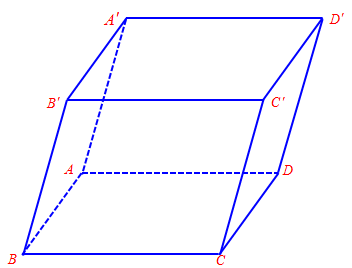
A. $\overrightarrow {AC’} = 3\overrightarrow {AG} $. B. $\overrightarrow {AC’} = 2\overrightarrow {AG} $. C. $\overrightarrow {AC’} = 4\overrightarrow {AG} $. D. $\overrightarrow {AC’} = \frac{1}{2}\overrightarrow {AG} $.
Lời giải
Chọn A
Theo quy tắt hình hộp ta có: $\overrightarrow {AB} + \overrightarrow {AA’} + \overrightarrow {AD} = \overrightarrow {AC’} $
Lại có, $G$ là trọng tâm tam giác $BA’D$$ \Rightarrow $$\overrightarrow {AB} + \overrightarrow {AA’} + \overrightarrow {AD} = 3\overrightarrow {AG} $
Suy ra, $\overrightarrow {AC’} = 3\overrightarrow {AG} $.
Câu 6. Cho hình tứ diện $ABCD$ có trọng tâm $G$. Mệnh đề nào sau đây sai.
A. $\overrightarrow {AG} = \frac{2}{3}\left( {\overrightarrow {AB} + \overrightarrow {AC} + \overrightarrow {AD} } \right)$. B. $\overrightarrow {AG} = \frac{1}{4}\left( {\overrightarrow {AB} + \overrightarrow {AC} + \overrightarrow {AD} } \right)$.
C. $\overrightarrow {OG} = \frac{1}{4}\left( {\overrightarrow {OA} + \overrightarrow {OB} + \overrightarrow {OC} + \overrightarrow {OD} } \right)$. D. $\overrightarrow {GA} + \overrightarrow {GB} + \overrightarrow {GC} + \overrightarrow {GD} = \overrightarrow 0 $.
Lời giải
Chọn A.
Theo giả thuyết trên thì với $O$ là một điểm bất kỳ ta luôn có: $\overrightarrow {OG} = \frac{1}{4}\left( {\overrightarrow {OA} + \overrightarrow {OB} + \overrightarrow {OC} + \overrightarrow {OD} } \right)$.
Ta thay điểm $O$ bởi điểm $A$ thì ta có:
$\overrightarrow {AG} = \frac{1}{4}\left( {\overrightarrow {AA} + \overrightarrow {AB} + \overrightarrow {AC} + \overrightarrow {AD} } \right)$$ \Leftrightarrow \overrightarrow {AG} = \frac{1}{4}\left( {\overrightarrow {AB} + \overrightarrow {AC} + \overrightarrow {AD} } \right)$
Do vậy $\overrightarrow {AG} = \frac{2}{3}\left( {\overrightarrow {AB} + \overrightarrow {AC} + \overrightarrow {AD} } \right)$ là sai.
Câu 7. Cho tứ diện$ABCD$. Gọi $P,{\text{ }}Q$ là trung điểm của $AB$ và $CD$. Chọn khẳng định đúng?
A. $\overrightarrow {PQ} = \frac{1}{4}\left( {\overrightarrow {BC} + \overrightarrow {AD} } \right)$. B. $\overrightarrow {PQ} = \frac{1}{2}\left( {\overrightarrow {BC} + \overrightarrow {AD} } \right)$.
C. $\overrightarrow {PQ} = \frac{1}{2}\left( {\overrightarrow {BC} – \overrightarrow {AD} } \right)$. D. $\overrightarrow {PQ} = \overrightarrow {BC} + \overrightarrow {AD} $.
Lời giải
Chọn B.
Ta có : $\overrightarrow {PQ} = \overrightarrow {PB} + \overrightarrow {BC} + \overrightarrow {CQ} $ và $\overrightarrow {PQ} = \overrightarrow {PA} + \overrightarrow {AD} + \overrightarrow {DQ} $
nên $2\overrightarrow {PQ} = \left( {\overrightarrow {PA} + \overrightarrow {PB} } \right) + \overrightarrow {BC} + \overrightarrow {AD} + \left( {\overrightarrow {CQ} + \overrightarrow {DQ} } \right) = \overrightarrow {BC} + \overrightarrow {AD} $. Vậy $\overrightarrow {PQ} = \frac{1}{2}\left( {\overrightarrow {BC} + \overrightarrow {AD} } \right)$
Câu 8. Trong không gian cho điểm $O$ và bốn điểm$A,B,C,D$ không thẳng hàng. Điều kiện cần và đủ để $A,B,C,D$ tạo thành hình bình hành là:
A. $\overrightarrow {OA} + \frac{1}{2}\overrightarrow {OB} = \overrightarrow {OC} + \frac{1}{2}\overrightarrow {OD} $. B. $\overrightarrow {OA} + \frac{1}{2}\overrightarrow {OC} = \overrightarrow {OB} + \frac{1}{2}\overrightarrow {OD} $.
C. $\overrightarrow {OA} + \overrightarrow {OC} = \overrightarrow {OB} + \overrightarrow {OD} $. D. $\overrightarrow {OA} + \overrightarrow {OB} + \overrightarrow {OC} + \overrightarrow {OD} = \overrightarrow 0 $.
Lời giải
Chọn C.
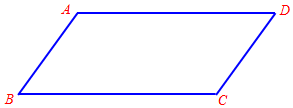
$\overrightarrow {OA} + \overrightarrow {OC} = \overrightarrow {OB} + \overrightarrow {OD} $$ \Leftrightarrow \overrightarrow {OA} + \overrightarrow {OA} + \overrightarrow {AC} = \overrightarrow {OA} + \overrightarrow {AB} + \overrightarrow {OA} + \overrightarrow {BC} $$ \Leftrightarrow \overrightarrow {AC} = \overrightarrow {AB} + \overrightarrow {BC} $
Câu 9. Trong không gian cho điểm $O$ và bốn điểm $A$, $B$, $C$, $D$ không thẳng hàng. Điều kiện cần và đủ để $A$, $B$, $C$, $D$ tạo thành hình bình hành là
A. $\overrightarrow {OA} + \overrightarrow {OB} + \overrightarrow {OC} + \overrightarrow {OD} = \vec 0$. B. $\overrightarrow {OA} + \overrightarrow {OC} = \overrightarrow {OB} + \overrightarrow {OD} $.
C. $\overrightarrow {OA} + \frac{1}{2}\overrightarrow {OB} = \overrightarrow {OC} + \frac{1}{2}\overrightarrow {OD} $. D. $\overrightarrow {OA} + \frac{1}{2}\overrightarrow {OC} = \overrightarrow {OB} + \frac{1}{2}\overrightarrow {OD} $.
Lời giải
Chọn B.
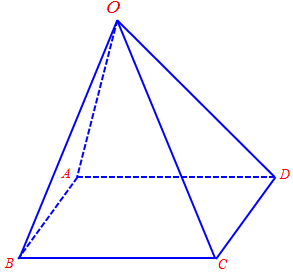
Trước hết, điều kiện cần và đủ để $ABCD$ là hình bình hành là:
$\overrightarrow {BD} = \overrightarrow {BA} + \overrightarrow {BC} $.
Với mọi điểm $O$ bất kì khác $A$, $B$, $C$, $D$, ta có:
$\overrightarrow {BD} = \overrightarrow {BA} + \overrightarrow {BC} \Leftrightarrow \overrightarrow {OD} – \overrightarrow {OB} = \overrightarrow {OA} – \overrightarrow {OB} + \overrightarrow {OC} – \overrightarrow {OB} $
$ \Leftrightarrow \overrightarrow {OA} + \overrightarrow {OC} = \overrightarrow {OB} + \overrightarrow {OD} $.
Câu 10. Cho tứ diện$ABCD$. Gọi $M,{\text{ }}N$ lần lượt là trung điểm của $AB,{\text{ }}CD$ và $G$ là trung điểm của$MN$. Trong các khẳng định sau, khẳng định nào sai?
A. $\overrightarrow {MA} + \overrightarrow {MB} + \overrightarrow {MC} + \overrightarrow {MD} = 4\overrightarrow {MG} $ B. $\overrightarrow {GA} + \overrightarrow {GB} + \overrightarrow {GC} = \overrightarrow {GD} $
C. $\overrightarrow {GA} + \overrightarrow {GB} + \overrightarrow {GC} + \overrightarrow {GD} = \overrightarrow 0 $ D. $\overrightarrow {GM} + \overrightarrow {GN} = \overrightarrow 0 $.
Lời giải
Chọn B.
$M,{\text{ }}N,\,\,G$ lần lượt là trung điểm của $AB,{\text{ }}CD,MN$ theo quy tắc trung điểm :
$\overrightarrow {GA} + \overrightarrow {GB} = 2\overrightarrow {GM} ;\overrightarrow {GC} + \overrightarrow {GD} = 2\overrightarrow {GN} ;\overrightarrow {GM} + \overrightarrow {GN} = \overrightarrow 0 $
Suy ra:$\overrightarrow {GA} + \overrightarrow {GB} + \overrightarrow {GC} + \overrightarrow {GD} = \overrightarrow 0 $ hay $\overrightarrow {GA} + \overrightarrow {GB} + \overrightarrow {GC} = – \overrightarrow {GD} $.
Câu 11. Cho tứ diện $ABCD$. Gọi $I,J$ lần lượt là trung điểm của $AB$ và $CD$, $G$ là trung điểm của $IJ$.
Cho các đẵng thức sau, đẳng thức nào đúng?
A. $\overrightarrow {GA} + \overrightarrow {GB} + \overrightarrow {GC} + \overrightarrow {GD} = \overrightarrow 0 $ B. $\overrightarrow {GA} + \overrightarrow {GB} + \overrightarrow {GC} + \overrightarrow {GD} = 2\overrightarrow {{\text{IJ}}} $
C. $\overrightarrow {GA} + \overrightarrow {GB} + \overrightarrow {GC} + \overrightarrow {GD} = \overrightarrow {JI} $ D. $\overrightarrow {GA} + \overrightarrow {GB} + \overrightarrow {GC} + \overrightarrow {GD} = – 2\overrightarrow {JI} $
Lời giải
Chọn A.
$\overrightarrow {GA} + \overrightarrow {GB} + \overrightarrow {GC} + \overrightarrow {GD} = \left( {\overrightarrow {GA} + \overrightarrow {GB} } \right) + \left( {\overrightarrow {GC} + \overrightarrow {GD} } \right)$$ = 2\overrightarrow {GI} + 2\overrightarrow {GJ} = 2\left( {\overrightarrow {GI} + \overrightarrow {GJ} } \right) = \overrightarrow 0 $.
Câu 12. Cho hình hộp $ABCD.{A_1}{B_1}{C_1}{D_1}$. Trong các khẳng định sau, khẳng định nào sai?
A. $\overrightarrow {A{C_1}} + \overrightarrow {{A_1}C} = 2\overrightarrow {AC} $. B. $\overrightarrow {A{C_1}} + \overrightarrow {C{A_1}} + 2\overrightarrow {{C_1}C} = \overrightarrow 0 $.
C. $\overrightarrow {A{C_1}} + \overrightarrow {{A_1}C} = \overrightarrow {A{A_1}} $. D. $\overrightarrow {C{A_1}} + \overrightarrow {AC} = \overrightarrow {C{C_1}} $.
Lời giải
Chọn A.
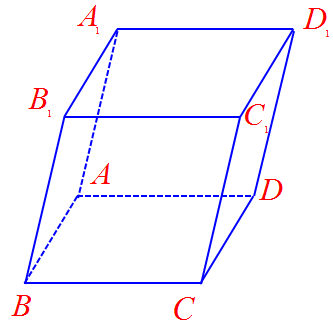
+ Gọi $O$ là tâm của hình hộp $ABCD.{A_1}{B_1}{C_1}{D_1}$.
+ Vận dụng công thức trung điểm để kiểm tra.
Câu 13. Cho hình hộp $ABCD.A’B’C’D’$ với tâm $O$. Hãy chỉ ra đẳng thức sai trong các đẳng thức sau đây:
A. $\overrightarrow {AB} + \overrightarrow {BC} + \overrightarrow {CC’} = \overrightarrow {AD’} + \overrightarrow {D’O} + \overrightarrow {OC’} $ B. $\overrightarrow {AB} + \overrightarrow {AA’} = \overrightarrow {AD} + \overrightarrow {DD’} $
C. $\overrightarrow {AB} + \overrightarrow {BC’} + \overrightarrow {CD} + \overrightarrow {D’A} = \overrightarrow 0 $ D. $\overrightarrow {AC’} = \overrightarrow {AB} + \overrightarrow {AD} + \overrightarrow {AA’} $.
Lời giải
Chọn B.
Ta có: $\overrightarrow {AB} + \overrightarrow {AA’} = \overrightarrow {AD} + \overrightarrow {DD’} \Leftrightarrow \overrightarrow {AB} = \overrightarrow {AD} $(vô lí)
Câu 14. Cho hình hộp $ABCD.{A_1}{B_1}{C_1}{D_1}$. Chọn đẳng thức sai?
A. $\overrightarrow {BC} + \overrightarrow {BA} = \overrightarrow {{B_1}{C_1}} + \overrightarrow {{B_1}{A_1}} $. B. $\overrightarrow {AD} + \overrightarrow {{D_1}{C_1}} + \overrightarrow {{D_1}{A_1}} = \overrightarrow {DC} $.
C. $\overrightarrow {BC} + \overrightarrow {BA} + \overrightarrow {B{B_1}} = \overrightarrow {B{D_1}} $. D. $\overrightarrow {BA} + \overrightarrow {D{D_1}} + \overrightarrow {B{D_1}} = \overrightarrow {BC} $.
Lời giải
Chọn D.
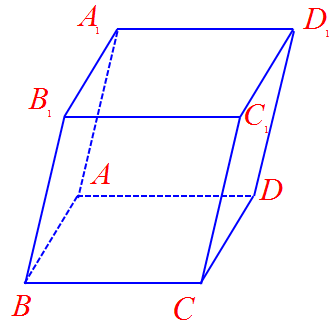
Ta có : $\overrightarrow {BA} + \overrightarrow {D{D_1}} + \overrightarrow {B{D_1}} = \overrightarrow {BA} + \overrightarrow {B{B_1}} + \overrightarrow {B{D_1}} = \overrightarrow {B{A_1}} + \overrightarrow {B{D_1}} \ne \overrightarrow {BC} $ nên D sai.
Do $\overrightarrow {BC} = \overrightarrow {{B_1}{C_1}} $và $\overrightarrow {BA} = \overrightarrow {{B_1}{A_1}} $ nên $\overrightarrow {BC} + \overrightarrow {BA} = \overrightarrow {{B_1}{C_1}} + \overrightarrow {{B_1}{A_1}} $. A đúng
Do $\overrightarrow {AD} + \overrightarrow {{D_1}{C_1}} + \overrightarrow {{D_1}{A_1}} = \overrightarrow {AD} + \overrightarrow {{D_1}{B_1}} = \overrightarrow {{A_1}{D_1}} + \overrightarrow {{D_1}{B_1}} = \overrightarrow {{A_1}{B_1}} = \overrightarrow {DC} $ nên
$\overrightarrow {AD} + \overrightarrow {{D_1}{C_1}} + \overrightarrow {{D_1}{A_1}} = \overrightarrow {DC} $ nên B đúng.
Do $\overrightarrow {BC} + \overrightarrow {BA} + \overrightarrow {B{B_1}} = \overrightarrow {BD} + \overrightarrow {D{D_1}} = \overrightarrow {B{D_1}} $ nên C đúng.
Câu 15. Cho hình lăng trụ tam giác $ABC.{A_1}{B_1}{C_1}$. Đặt $\overrightarrow {A{A_1}} = \overrightarrow a ,\overrightarrow {AB} = \overrightarrow b ,\overrightarrow {AC} = \overrightarrow c ,\overrightarrow {BC} = \overrightarrow d ,$trong các đẳng thức sau, đẳng thức nào đúng?
A. $\overrightarrow a + \overrightarrow b + \overrightarrow c + \overrightarrow d = \overrightarrow 0 $. B. $\overrightarrow a + \overrightarrow b + \overrightarrow c = \overrightarrow d $. C. $\overrightarrow b – \overrightarrow c + \overrightarrow d = \overrightarrow 0 $. D. $\overrightarrow a = \overrightarrow b + \overrightarrow c $.
Lời giải
Chọn C.
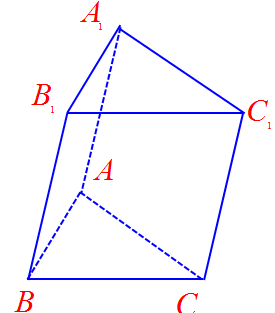
+ Dễ thấy: $\overrightarrow {AB} + \overrightarrow {BC} + \overrightarrow {CA} = \overrightarrow 0 \Rightarrow \overrightarrow b + \overrightarrow d – \overrightarrow c = \overrightarrow 0 $.
Câu 16. Gọi $M,N$ lần lượt là trung điểm của các cạnh $AC$ và $BD$ của tứ diện$ABCD$. Gọi $I$ là trung điểm đoạn $MN$ và $P$ là 1 điểm bất kỳ trong không gian. Tìm giá trị của $k$ thích hợp điền vào đẳng thức vectơ: $\overrightarrow {IA} + (2k – 1)\overrightarrow {IB} + k\overrightarrow {IC} + \overrightarrow {ID} = \overrightarrow 0 $
A. $k = 2$. B. $k = 4$. C. $k = 1$. D. $k = 0$.
Lời giải
Chọn C.
Ta chứng minh được $\overrightarrow {IA} + \overrightarrow {IB} + \overrightarrow {IC} + \overrightarrow {ID} = \overrightarrow 0 $ nên $k = 1$
Câu 17. Cho tứ diện $ABCD$. Gọi $G$ là trọng tâm tam giác $ABC.$ Tìm giá trị của $k$ thích hợp điền vào đẳng thức vectơ: $\overrightarrow {DA} + \overrightarrow {DB} + \overrightarrow {DC} = k\overrightarrow {DG} $
A. $k = \frac{1}{3}$. B. $k = 2.$ C. $k = 3.$ D. $k = \frac{1}{2}$.
Lời giải
Chọn C.
ta có $\overrightarrow {DA} + \overrightarrow {DB} + \overrightarrow {DC} = 3\overrightarrow {DG} $.
Suy ra, $k=3$
Câu 18. Cho hình hộp $ABCD.A’B’C’D’$. Tìm giá trị của $k$ thích hợp điền vào đẳng thức vectơ: $\overrightarrow {AC} + \overrightarrow {BA’} + k\left( {\overrightarrow {DB} + \overrightarrow {C’D} } \right) = \overrightarrow 0 $.
A. $k = 0$. B. $k = 1$. C. $k = 4$. D. $k = 2$.
Lời giải
Chọn B.
Với $k = 1$ ta có: $\overrightarrow {AC} + \overrightarrow {BA’} + 1.\left( {\overrightarrow {DB} + \overrightarrow {C’D} } \right) = \overrightarrow {AC} + \overrightarrow {BA’} + \overrightarrow {C’B} = \overrightarrow {AC} + \overrightarrow {C’A’} = \overrightarrow {AC} + \overrightarrow {CA} = \overrightarrow 0 $
Suy ra, $k=1$
DẠNG 2: PHÂN TÍCH MỘT VECTƠ THEO CÁC VECTƠ
Câu 19. Cho tứ diện $ABCD$. Đặt $\overrightarrow {AB} = \overrightarrow a ,\overrightarrow {AC} = \overrightarrow b ,\overrightarrow {AD} = \overrightarrow c ,$ gọi $G$ là trọng tâm của tam giác$BCD$. Trong các đẳng thức sau, đẳng thức nào đúng?
A. $\overrightarrow {AG} = \overrightarrow a + \overrightarrow b + \overrightarrow c $. B. $\overrightarrow {AG} = \frac{1}{3}\left( {\overrightarrow a + \overrightarrow b + \overrightarrow c } \right)$. C. $\overrightarrow {AG} = \frac{1}{2}\left( {\overrightarrow a + \overrightarrow b + \overrightarrow c } \right)$. D. $\overrightarrow {AG} = \frac{1}{4}\left( {\overrightarrow a + \overrightarrow b + \overrightarrow c } \right)$.
Lời giải
Chọn C.
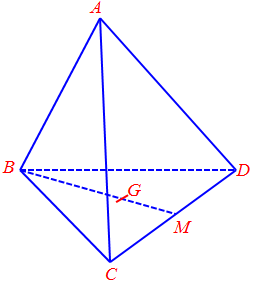
Gọi $M$ là trung điểm $BC$.
$\overrightarrow {AG} = \overrightarrow {AB} + \overrightarrow {BG} = \overrightarrow a + \frac{2}{3}\overrightarrow {BM} $$ = \overrightarrow a + \frac{2}{3}.\frac{1}{2}\left( {\overrightarrow {BC} + \overrightarrow {BD} } \right)$
$\quad {\kern 1pt} {\kern 1pt} {\kern 1pt} {\kern 1pt} = \overrightarrow a + \frac{1}{3}\left( {\overrightarrow {AC} – \overrightarrow {AB} + \overrightarrow {AD} – \overrightarrow {AB} } \right)$$ = \overrightarrow a + \frac{1}{3}\left( { – 2\overrightarrow a + \overrightarrow b + \overrightarrow c } \right) = \frac{1}{3}\left( {\overrightarrow a + \overrightarrow b + \overrightarrow c } \right).$
Câu 20. Cho tứ diện $ABCD$. Đặt $\overrightarrow {AB} = \overrightarrow a ,\,\,\overrightarrow {AC} = \overrightarrow b ,\,\,\overrightarrow {AD} = \overrightarrow c ,$ gọi $M$ là trung điểm của $BC.$ Trong các khẳng định sau, khẳng định nào đúng?
A. $\overrightarrow {DM} = \frac{1}{2}\left( {\overrightarrow a + \overrightarrow b – 2\overrightarrow c } \right)$ B. $\overrightarrow {DM} = \frac{1}{2}\left( { – 2\overrightarrow a + \overrightarrow b + \overrightarrow c } \right)$
C. $\overrightarrow {DM} = \frac{1}{2}\left( {\overrightarrow a – 2\overrightarrow b + \overrightarrow c } \right)$. D. $\overrightarrow {DM} = \frac{1}{2}\left( {\overrightarrow a + 2\overrightarrow b – \overrightarrow c } \right)$
Lời giải
Chọn A
Ta có: $\overrightarrow {DM} = \overrightarrow {DA} + \overrightarrow {AB} + \overrightarrow {BM} $$ = \overrightarrow {AB} – \overrightarrow {AD} + \frac{1}{2}\overrightarrow {BC} $
$ = \overrightarrow {AB} – \overrightarrow {AD} + \frac{1}{2}\left( {\overrightarrow {BA} + \overrightarrow {AC} } \right)$
$ = \frac{1}{2}\overrightarrow {AB} + \frac{1}{2}\overrightarrow {AC} – \overrightarrow {AD} $$ = \frac{1}{2}\overrightarrow a + \frac{1}{2}\overrightarrow b – \overrightarrow c = \frac{1}{2}\left( {\overrightarrow a + \overrightarrow b – 2\overrightarrow c } \right).$
Câu 21. Cho tứ diện $ABCD$. Gọi $M$ và $P$ lần lượt là trung điểm của $AB$ và $CD$. Đặt $\overrightarrow {AB} = \overrightarrow b $,$\overrightarrow {AC} = \overrightarrow c $,$\overrightarrow {AD} = \overrightarrow d $. Khẳng định nào sau đây đúng.
A. $\overrightarrow {MP} = \frac{1}{2}(\overrightarrow c + \overrightarrow d + \overrightarrow b )$. B. $\overrightarrow {MP} = \frac{1}{2}(\overrightarrow d + \overrightarrow b – \overrightarrow c )$.
C. $\overrightarrow {MP} = \frac{1}{2}(\overrightarrow c + \overrightarrow b – \overrightarrow d )$. D. $\overrightarrow {MP} = \frac{1}{2}(\overrightarrow c + \overrightarrow d – \overrightarrow b )$.
Lời giải
Chọn D.
Ta có $\overrightarrow c + \overrightarrow d – \overrightarrow b = \overrightarrow {AC} + \overrightarrow {AD} – \overrightarrow {AB} = 2\overrightarrow {AP} – 2\overrightarrow {AM} = 2\left( {\overrightarrow {MP} } \right) \Leftrightarrow \overrightarrow {MP} = \frac{1}{2}(\overrightarrow c + \overrightarrow d – \overrightarrow b )$.
Câu 22. Cho hình lập phương $ABCD.{A_1}{B_1}{C_1}{D_1}$. Gọi $O$ là tâm của hình lập phương. Chọn đẳng thức đúng?
A. $\overrightarrow {AO} = \frac{1}{3}\left( {\overrightarrow {AB} + \overrightarrow {AD} + \overrightarrow {A{A_1}} } \right)$ B. $\overrightarrow {AO} = \frac{1}{2}\left( {\overrightarrow {AB} + \overrightarrow {AD} + \overrightarrow {A{A_1}} } \right)$
C. $\overrightarrow {AO} = \frac{1}{4}\left( {\overrightarrow {AB} + \overrightarrow {AD} + \overrightarrow {A{A_1}} } \right)$ D. $\overrightarrow {AO} = \frac{2}{3}\left( {\overrightarrow {AB} + \overrightarrow {AD} + \overrightarrow {A{A_1}} } \right)$.
Lời giải
Chọn B.
Theo quy tắc hình hộp: $\overrightarrow {A{C_1}} = \overrightarrow {AB} + \overrightarrow {AD} + \overrightarrow {A{A_1}} $
Mà $\overrightarrow {AO} = \frac{1}{2}\overrightarrow {A{C_1}} $ nên $\overrightarrow {AO} = \frac{1}{2}\left( {\overrightarrow {AB} + \overrightarrow {AD} + \overrightarrow {A{A_1}} } \right)$.
Câu 23. Cho lăng trụ tam giác $ABC.A’B’C’$ có $\overrightarrow {AA’} = \overrightarrow a ,\overrightarrow {\,AB} = \overrightarrow {b,} \,\overrightarrow {AC} = \overrightarrow c $. Hãy phân tích (biểu thị) vectơ $\overrightarrow {BC’} $ qua các vectơ $\overrightarrow a ,\,\overrightarrow b ,\,\,\overrightarrow c $.
A. $\overrightarrow {BC’} = \overrightarrow a + \overrightarrow b – \overrightarrow c $ B. $\overrightarrow {BC’} = – \overrightarrow a + \overrightarrow b – \overrightarrow c $ C. $\overrightarrow {BC’} = – \overrightarrow a – \overrightarrow b + \overrightarrow c $ D. $\overrightarrow {BC’} = \overrightarrow a – \overrightarrow b + \overrightarrow c $.
Lời giải
Chọn D.
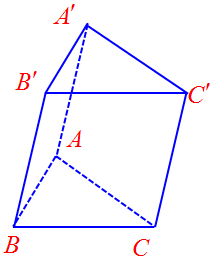
Ta có: $\overrightarrow {BC’} = \overrightarrow {BA} + \overrightarrow {AC’} = – \overrightarrow {AB} + \overrightarrow {AC} + \overrightarrow {AA’} = – \overrightarrow b + \overrightarrow c + \overrightarrow a = \overrightarrow a – \overrightarrow b + \overrightarrow c $.
Câu 24. Cho lăng trụ tam giác $ABC.A’B’C’$ có $\overrightarrow {AA’} = \overrightarrow a ,\overrightarrow {\,AB} = \overrightarrow {b,} \,\overrightarrow {AC} = \overrightarrow c $. Hãy phân tích (biểu thị) vectơ $\overrightarrow {B’C} $ qua các vectơ $\overrightarrow a ,\,\,\overrightarrow b ,\,\,\overrightarrow c $.
A. $\overrightarrow {B’C} = \overrightarrow a + \overrightarrow b – \overrightarrow c .$ B. $\overrightarrow {B’C} = – \overrightarrow a + \overrightarrow b + \overrightarrow c .$ C. $\overrightarrow {B’C} = \overrightarrow a + \overrightarrow b + \overrightarrow c .$ D. $\overrightarrow {B’C} = – \overrightarrow a – \overrightarrow b + \overrightarrow c .$
Lời giải
Chọn D.
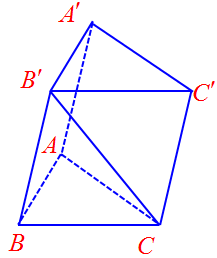
Theo quy tắc hình bình hành ta có:
$\overrightarrow {B’C} = \overrightarrow {B’B} + \overrightarrow {B’C’} $$ = – \overrightarrow {AA’} + \overrightarrow {BC} = – \overrightarrow a + \overrightarrow {AC} – \overrightarrow {AB} = – \overrightarrow a – \overrightarrow b + \overrightarrow c .$
Câu 25. Cho hình lăng trụ $ABCA’B’C’$, $M$ là trung điểm của. Đặt $\overrightarrow {CA} = \overrightarrow a $,$\overrightarrow {CB} = \overrightarrow b $, $\overrightarrow {AA’} = \overrightarrow c $. Khẳng định nào sau đây đúng?
A. $\overrightarrow {AM} = \overrightarrow a + \overrightarrow c – \frac{1}{2}\overrightarrow b $ B. $\overrightarrow {AM} = \overrightarrow b + \overrightarrow c – \frac{1}{2}\overrightarrow a $. C. $\overrightarrow {AM} = \overrightarrow b – \overrightarrow a + \frac{1}{2}\overrightarrow c $. D. $\overrightarrow {AM} = \overrightarrow a – \overrightarrow c + \frac{1}{2}\overrightarrow b $.
Lời giải
Chọn C.
Ta có $\overrightarrow {AM} = \overrightarrow {AB} + \overrightarrow {BM} = \overrightarrow {CB} – \overrightarrow {CA} + \frac{1}{2}\overrightarrow {BB’} = \overrightarrow b – \overrightarrow a + \frac{1}{2}\overrightarrow c $
Câu 26. Cho hình hộp $ABCD.A’B’C’D’$ có tâm $O$. Gọi $I$ là tâm hình bình hành $ABCD$. Đặt $\overrightarrow {AC’} = \vec u$,$\overrightarrow {CA’} = \vec v$, $\overrightarrow {BD’} = \vec x$, $\overrightarrow {DB’} = \vec y$. Khẳng định nào sau đây đúng?
A. $2\overrightarrow {OI} = \frac{1}{2}\left( {\vec u + \vec v + \vec x + \vec y} \right)$. B. $2\overrightarrow {OI} = – \frac{1}{2}\left( {\vec u + \vec v + \vec x + \vec y} \right)$.
C. $2\overrightarrow {OI} = \frac{1}{4}\left( {\vec u + \vec v + \vec x + \vec y} \right)$. D. $2\overrightarrow {OI} = – \frac{1}{4}\left( {\vec u + \vec v + \vec x + \vec y} \right)$.
Lời giải
Chọn D.
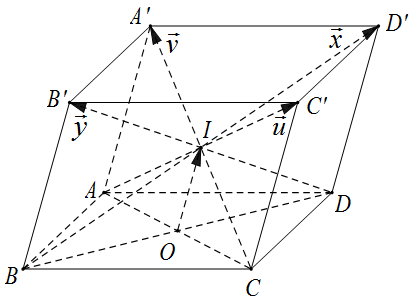
Ta phân tích:
$\vec u + \vec v = \overrightarrow {AC’} + \overrightarrow {CA’} = \left( {\overrightarrow {AC} + \overrightarrow {CC’} } \right) + \left( {\overrightarrow {CA} + \overrightarrow {AA’} } \right) = 2\overrightarrow {AA’} $.
$\vec x + \vec y = \overrightarrow {BD’} + \overrightarrow {DB’} $
$ = \left( {\overrightarrow {BD} + \overrightarrow {DD’} } \right) + \left( {\overrightarrow {DB} + \overrightarrow {BB’} } \right) = 2\overrightarrow {BB’} = 2\overrightarrow {AA’} $.
$ \Rightarrow \vec u + \vec v + \vec x + \vec y = 4\overrightarrow {AA’} = – 4\overrightarrow {A’A} = – 4.2\overrightarrow {OI} $.
$ \Rightarrow 2\overrightarrow {OI} = – \frac{1}{4}\left( {\vec u + \vec v + \vec x + \vec y} \right)$.
Câu 27. Cho hình hộp $ABCD.{A_1}{B_1}{C_1}{D_1}$. Gọi $M$ là trung điểm $AD$. Chọn đẳng thức đúng.
A. $\overrightarrow {{B_1}M} = \overrightarrow {{B_1}B} + \overrightarrow {{B_1}{A_1}} + \overrightarrow {{B_1}{C_1}} $. B. $\overrightarrow {{C_1}M} = \overrightarrow {{C_1}C} + \overrightarrow {{C_1}{D_1}} + \frac{1}{2}\overrightarrow {{C_1}{B_1}} $.
C. $\overrightarrow {{C_1}M} = \overrightarrow {{C_1}C} + \frac{1}{2}\overrightarrow {{C_1}{D_1}} + \frac{1}{2}\overrightarrow {{C_1}{B_1}} $. D. $\overrightarrow {B{B_1}} + \overrightarrow {{B_1}{A_1}} + \overrightarrow {{B_1}{C_1}} = 2\overrightarrow {{B_1}D} $.
Lời giải
Chọn B.
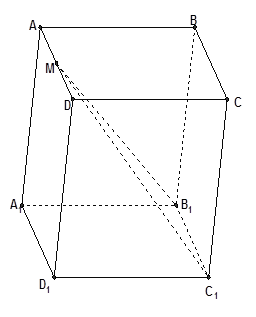
A. Sai vì $\overrightarrow {{B_1}M} = \overrightarrow {{B_1}B} + \overrightarrow {BM} = \overrightarrow {B{B_1}} + \frac{1}{2}\left( {\overrightarrow {BA} + \overrightarrow {BD} } \right) = \overrightarrow {B{B_1}} + \frac{1}{2}\left( {\overrightarrow {{B_1}{A_1}} + \overrightarrow {{B_1}{D_1}} } \right)$
$ = \overrightarrow {B{B_1}} + \frac{1}{2}\left( {\overrightarrow {{B_1}{A_1}} + \overrightarrow {{B_1}{A_1}} + \overrightarrow {{B_1}{C_1}} } \right) = \overrightarrow {B{B_1}} + \overrightarrow {{B_1}{A_1}} + \frac{1}{2}\overrightarrow {{B_1}{C_1}} .$
B. Đúng vì $\overrightarrow {{C_1}M} = \overrightarrow {{C_1}C} + \overrightarrow {CM} = \overrightarrow {{C_1}C} + \frac{1}{2}\left( {\overrightarrow {CA} + \overrightarrow {CD} } \right) = \overrightarrow {{C_1}C} + \frac{1}{2}\left( {\overrightarrow {{C_1}{A_1}} + \overrightarrow {{C_1}{D_1}} } \right)$
$ = \overrightarrow {{C_1}C} + \frac{1}{2}\left( {\overrightarrow {{C_1}{B_1}} + \overrightarrow {{C_1}{D_1}} + \overrightarrow {{C_1}{D_1}} } \right) = \overrightarrow {{C_1}C} + \overrightarrow {{C_1}{D_1}} + \frac{1}{2}\overrightarrow {{C_1}{B_1}} .$
C. Sai. theo câu B suy ra
D. Đúng vì $\overrightarrow {B{B_1}} + \overrightarrow {{B_1}{A_1}} + \overrightarrow {{B_1}{C_1}} = \overrightarrow {B{A_1}} + \overrightarrow {BC} = \overrightarrow {B{D_1}} $.
DẠNG 3: HAI VECTƠ CÙNG PHƯƠNG-BA ĐIỂM THẲNG HÀNG-TẬP HỢP ĐIỂM THỎA MÃN ĐẲNG THỨC VECTƠ
Câu 28. Cho $\overrightarrow x = 2\overrightarrow a + \overrightarrow b ;\,\overrightarrow y = – 6\overrightarrow a – 3\overrightarrow b $. Chọn mệnh đề đúng nhất?
A. Hai vecto $\overrightarrow x $ và $\overrightarrow y $ là cùng phương
B. Hai vecto $\overrightarrow x $ và $\overrightarrow y $ là cùng phương và cùng hướng
C. Hai vecto $\overrightarrow x $ và $\overrightarrow y $ là cùng phương và ngược hướng
D. Hai vecto $\overrightarrow x $ và $\overrightarrow y $ là không cùng phương
Lời giải
Chọn C.
Ta có: $\,\overrightarrow y = – 6\overrightarrow a – 3\overrightarrow b = – 3\left( {2\overrightarrow a + \overrightarrow b } \right) \Rightarrow \overrightarrow y = – 3\overrightarrow x $
⇒ $\overrightarrow x $ và $\overrightarrow y $ là cùng phương và ngược hướng.
Câu 29. Cho ba vectơ $\overrightarrow a ,\overrightarrow b ,\overrightarrow c $ không đồng phẳng. Xét các vectơ $\overrightarrow x = 2\overrightarrow a – \overrightarrow b ;\,\overrightarrow y = – 4\overrightarrow a + 2\overrightarrow b ;\,\overrightarrow z = – 3\overrightarrow b – 2\overrightarrow c \,$. Chọn khẳng định đúng?
A. Haivectơ $\overrightarrow y ;\overrightarrow z $ cùng phương. B. Haivectơ $\overrightarrow x ;\overrightarrow y $ cùng phương.
C. Haivectơ $\overrightarrow x ;\overrightarrow z $ cùng phương. D. Đáp án A, B, C, đều sai.
Lời giải
Chọn B.
Nhận thấy: $\overrightarrow y = – 2\overrightarrow x $ nên hai vectơ $\overrightarrow x ;\overrightarrow y $ cùng phương.
Câu 30. Cho tứ diện $ABCD$ và điểm $G$ thỏa mãn $\overrightarrow {GA} + \overrightarrow {GB} + \overrightarrow {GC} + \overrightarrow {GD} = \overrightarrow 0 $ ($G$ là trọng tâm của tứ diện). Gọi ${G_O}$ là giao điểm của $GA$ và mp $(BCD)$. Trong các khẳng định sau, khẳng định nào đúng?
A. $\overrightarrow {GA} = – 2\overrightarrow {{G_0}G} $. B. $\overrightarrow {GA} = 4\overrightarrow {{G_0}G} $. C. $\overrightarrow {GA} = 3\overrightarrow {{G_0}G} $. D. $\overrightarrow {GA} = 2\overrightarrow {{G_0}G} $.
Lời giải
Chọn C.
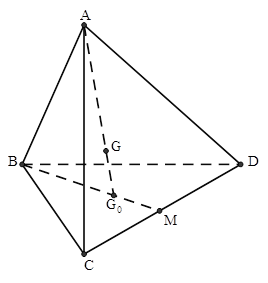
Theo đề: ${G_O}$ là giao điểm của $GA$ và mp $\left( {BCD} \right)$$ \Rightarrow {G_0}$ là trọng tâm tam giác $BCD$.
$ \Rightarrow \overrightarrow {{G_0}A} + \overrightarrow {{G_0}B} + \overrightarrow {{G_0}C} = \overrightarrow 0 $
Ta có: $\overrightarrow {GA} + \overrightarrow {GB} + \overrightarrow {GC} + \overrightarrow {GD} = \overrightarrow 0 $
$ \Rightarrow \overrightarrow {GA} = – \left( {\overrightarrow {GB} + \overrightarrow {GC} + \overrightarrow {GD} } \right) = – \left( {3\overrightarrow {G{G_0}} + \overrightarrow {{G_0}A} + \overrightarrow {{G_0}B} + \overrightarrow {{G_0}C} } \right) = – 3\overrightarrow {G{G_0}} = 3\overrightarrow {{G_0}G} $
Câu 31. Cho hình chóp $S.ABCD$ có đáy là hình bình hành tâm $O.$ Gọi $G$ là điểm thỏa mãn: $\overrightarrow {GS} + \overrightarrow {GA} + \overrightarrow {GB} + \overrightarrow {GC} + \overrightarrow {GD} = \overrightarrow 0 $. Trong các khẳng định sau, khẳng định nào đúng?
A. $G,{\text{ }}S,{\text{ }}O$ không thẳng hàng. B. $\overrightarrow {GS} = 4\overrightarrow {OG} $
C. $\overrightarrow {GS} = 5\overrightarrow {OG} $ D. $\overrightarrow {GS} = 3\overrightarrow {OG} $.
Lời giải
Chọn B.
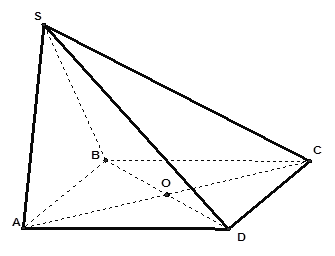
$\overrightarrow {GS} + \overrightarrow {GA} + \overrightarrow {GB} + \overrightarrow {GC} + \overrightarrow {GD} = \overrightarrow 0 $$ \Leftrightarrow \overrightarrow {GS} + 4\overrightarrow {GO} + \left( {\overrightarrow {OA} + \overrightarrow {OB} + \overrightarrow {OC} + \overrightarrow {OD} } \right) = \overrightarrow 0 $
$ \Leftrightarrow \overrightarrow {GS} + 4\overrightarrow {GO} = \overrightarrow 0 $$ \Leftrightarrow \overrightarrow {GS} = 4\overrightarrow {OG} $
DẠNG 4 : BÀI TOÁN THỰC TIỄN ỨNG DỤNG VECTƠ TRONG KHÔNG GIAN
Câu 32. Một chiếc bàn học sinh cân đối hình chữ nhật được đặt trên mặt sàn nằm ngang, mặt bàn song song với mặt sàn và bốn chân bàn vuông góc với mặt sàn như hình vẽ. Trọng lực tác dụng lên bàn được biểu thị bởi vectơ $\overrightarrow a $ phân tán đều qua bốn chân bàn và gây nên các phản lực từ mặt sàn lên các chân bàn được biểu thị bởi các vectơ $\overrightarrow b ,\overrightarrow c ,\overrightarrow d ,\overrightarrow e $.

Trong các mệnh đề sau, mệnh đề nào sai?
A. Vectơ $\overrightarrow d $ ngược hướng với vectơ $\overrightarrow a $.
B. Các vectơ $\overrightarrow b ,\overrightarrow c ,\overrightarrow d ,\overrightarrow e $ cùng phương và ngược chiều với vectơ $\overrightarrow a $.
C. Vectơ $\overrightarrow b $ với vectơ $\overrightarrow a $ đối nhau.
D. Các vectơ $\overrightarrow b ,\overrightarrow c ,\overrightarrow d ,\overrightarrow e $ đôi một cùng chiều và cùng độ lớn.
Lời giải
Chọn C
Do bốn chân bàn vuông góc với mặt sàn và với mặt bàn nên các vectơ $\overrightarrow b ,\overrightarrow c ,\overrightarrow d ,\overrightarrow e $ cùng phương và ngược chiều với vectơ $\overrightarrow a $.
Trọng lực tác dụng lên bàn được biểu thị bởi vectơ $\overrightarrow a $ phân tán đều qua bốn chân bàn nên các vectơ $\overrightarrow b ,\overrightarrow c ,\overrightarrow d ,\overrightarrow e $ đôi một cùng chiều và cùng độ lớn.
Vectơ $\overrightarrow b $ với vectơ $\overrightarrow a $ ngược hướng chứ không phải đối nhau vì hai vectơ đối nhgau là hai vectơ cùng ngược hướng, cùng độ dài. Đáp án C sai
Câu 33. Một tấm gỗ tròn được treo song song với mặt phẳng nằm ngang bởi ba sợi dây không giãn xuất phát từ điểm $O$ trên trần nhà và lần lượt buộc vào ba điểm $A,B,C$ trên tấm gỗ tròn sao cho các lực căng $\overrightarrow {{F_1}} ,\overrightarrow {{F_2}} ,\overrightarrow {{F_3}} $ lần lượt trên mỗi dây $OA,OB,OC$ đôi một vuông góc với nhau và có độ lớn $\left| {\overrightarrow {{F_1}} } \right| = \left| {\overrightarrow {{F_2}} } \right| = \left| {\overrightarrow {{F_3}} } \right| = 10\left( N \right)$ (xem hình vẽ).

Tính trọng lượng $P$ của tấm gỗ tròn đó.
A. $30\sqrt 3 $. B. $10$. C. $10\sqrt 2 $. D. $10\sqrt 3 $.
Lời giải
Chọn D

Gọi ${A_1},{B_1},{C_1}$ lần lượt là các điểm sao cho $\overrightarrow {O{A_1}} = \overrightarrow {{F_1}} ,{\text{ }}\overrightarrow {O{B_1}} = \overrightarrow {{F_2}} ,{\text{ }}\overrightarrow {O{C_1}} = \overrightarrow {{F_3}} $
Lấy các điểm ${D_1},A_1′,B_1′,D_1’$ sao cho $O{A_1}{D_1}{B_1}.{C_1}A_1’D_1’B_1’$ là hình hộp .
Theo quy tắc hình hộp ta có: $\overrightarrow {O{A_1}} + \overrightarrow {O{B_1}} + \overrightarrow {O{C_1}} = \overrightarrow {OD_1′} $
Do các lực căng $\overrightarrow {{F_1}} ,\overrightarrow {{F_2}} ,\overrightarrow {{F_3}} $ đôi một vuông góc với nhau và có độ lớn: $\left| {\overrightarrow {{F_1}} } \right| = \left| {\overrightarrow {{F_2}} } \right| = \left| {\overrightarrow {{F_3}} } \right| = 10\left( N \right)$ nên hình hộp $O{A_1}{D_1}{B_1}.{C_1}A_1’D_1’B_1’$ có ba cạnh $OA,OB,OC$ đôi một vuông góc và bằng nhau.
Vì vậy $O{A_1}{D_1}{B_1}.{C_1}A_1’D_1’B_1’$ là hình lập phương có độ dài cạnh bằng $10$, suy ra độ dài đường chéo bằng $10\sqrt 3 $
Vì tấm gỗ tròn ở vị trí cân bằng nên: $\overrightarrow P = \overrightarrow {{F_1}} + \overrightarrow {{F_2}} + \overrightarrow {{F_3}} $
Suy ra trọng lượng của tấm gỗ tròn: $\left| {\overrightarrow P } \right| = \left| {\overrightarrow {OD_1′} } \right| = 10\sqrt 3 \left( N \right)$
Câu 34. Một chiếc ô tô được đặt trên mặt đáy dưới một khung sắt có dạng hình hộp chữ nhật với đáy trên là hình chữ nhật $ABCD$, mặt phẳng $\left( {ABCD} \right)$ song song với mặt mặt phẳng nằm ngang. Khung sắt đó được buộc vào móc $E$ của chiến cần cẩu sao cho các đoạn dây cáp $EA,EB,EC,ED$có độ dài bằng nhau và cùng tạo với mặt phẳng $\left( {ABCD} \right)$ một góc ${60^0}$ như hình vẽ. Chiếc cần cẩu kéo khung sắt lên theo phương thẳng đứng. Biết lực căng $\overrightarrow {{F_1}} ,\overrightarrow {{F_2}} ,\overrightarrow {{F_3}} ,\overrightarrow {{F_4}} $ đều có cường độ $5000\left( N \right)$ và trọng lượng khung sắt là $2000\left( N \right)$. Trọng lượng của chiếc xe ô tô gần nhất số nào sau đây?

A. $15321\left( N \right)$. B. $6660\left( N \right)$. C. $5000\left( N \right)$. D. $10000\left( N \right)$.
Lời giải
Chọn A
Gọi O là tâm hình chữ nhật $ABCD$, Theo bài toán thì là hình chóp $E.ABCD$ có đường cao là $EO$

Theo quy tắc hình bình hành: $\overrightarrow {{F_1}} + \overrightarrow {{F_3}} = 2\overrightarrow {EO} ;{\text{ }}\overrightarrow {{F_2}} + \overrightarrow {{F_4}} = 2\overrightarrow {EO} $
$ \Rightarrow \overrightarrow {{F_1}} + \overrightarrow {{F_3}} + \overrightarrow {{F_2}} + \overrightarrow {{F_4}} = 4\overrightarrow {EO} $
dây cáp $EA,EB,EC,ED$có độ dài bằng nhau và cùng tạo với mặt phẳng $\left( {ABCD} \right)$ một góc ${60^0}$ nên:
$ \Rightarrow EO = EA.\sin {60^0} = 5000.\frac{{\sqrt 3 }}{2} = 2500\sqrt 3 $
Vì chiếc xe ô tô ở vị trí cân bằng nên: $\overrightarrow P = \overrightarrow {{F_1}} + \overrightarrow {{F_2}} + \overrightarrow {{F_3}} + \overrightarrow {{F_4}} + \overrightarrow {{P_1}} $
Suy ra trọng lượng của chiếc xe ô tô: $\left| {\overrightarrow P } \right| + 2000 = 4\left| {\overrightarrow {EO} } \right| \Rightarrow \left| {\overrightarrow P } \right| = 4.2500\sqrt 3 – 2000 \approx 15321\left( N \right)$







